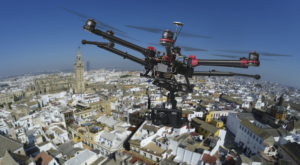
AI-Based Drone Floated to Enforce Social Distancing

via Shutterstock
If desperate times call for desperate measures, then an AI-powered surveillance drone may find applications as pandemic fatigue erodes compliance with social distancing advisories in congested urban areas.
At least that’s the pitch from AI and analytics vendor Fractal Analytics, which has partnered with Indian drone technology manufacturer ideaForge to develop a flying video analytics platform. The partners claim the combination can be used to identify small crowds, generating alarms that are sent to local authorities.
Fractal notes that its drone monitors along with those from other developers are being used by authorities in India. Indeed, the journal New Scientist has reported on the U.S. startup Skylark Labs is also testing the technology in six Indian cities. The drones are being used to monitor compliance with evening curfews and social distancing in crowded cities.
The journal also reported on a drone system in Portugal equipped with a loudspeaker that spots and warns violators to keep their distance.
Whether AI-powered drone technology flies in the U.S. remains to be seen, given the civil liberties issues raised by aerial surveillance. Among the concerns is whether flying video analytics platforms include facial recognition capabilities that would conflict with data privacy regulations.
Undeterred, Fractal promotes its video analytics platform as helping reduce compliance infractions that would slow the current COVID-19 wildfire. The New York-based company whose technology is primarily used to stream applications from the cloud said its AI-driven image and video analytics scans video captured by ideaForge drones. It then alerts authorities to compliance violations, forwarding real-time video and location coordinates.
Drone footage is available here.
As COVID-19 infections and deaths spike, the company maintains “data generated during these flights provide law enforcement with the insights needed to help make strategic decisions.”
Still, many of the most egregious violations of social distancing rules occur during large indoor gatherings.
For example, several high-profile gatherings have been broken up by authorities in New York City, Los Angeles and other large U.S. cities. In one recent incident, residents of a suburban neighborhood reported to unusually heavy local traffic to authorities around a Long Island estate where 400 persons attended a party.
(Fractal has yet to respond to our query as to whether its platform includes facial recognition technology.)
Either way, the surveillance approach has its critics. “We cannot surveil and police our way out of an epidemic,” Matthew Guariglia at the Electronic Frontier Foundation, told the New Scientist.
Recent items:
How Badly Will COVID-19 Hurt the Data Privacy Movement?
Data Privacy Is on the Defensive During the Coronavirus Panic




























